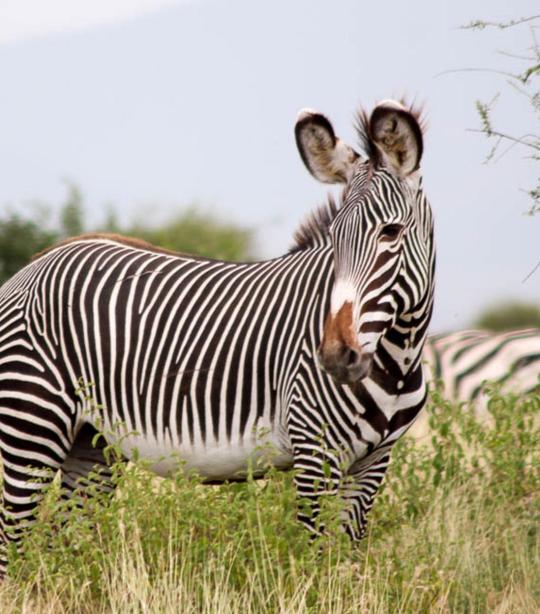Mini Sheet: Zebra (Cinderellas 2012)
Zebra (Cinderellas 2012)
01 January (Cinderellas ) within release République Démocratique du Congo : Katanga goes into circulation Mini Sheet Zebra face value 6*45 No Face Value
| Mini Sheet Zebra in catalogues | |
|---|---|
| Colnect codes: | Col: KT 2012-12 |
Mini Sheet is square format.
Sheet of cinderella stamps issued by the so-called "Africa Federation of Free States". Denomination is fictitious, sheets were sold online for GBP 2.20.Also in the issue République Démocratique du Congo : Katanga:
- Mini Sheet - Blackbird face value 6*20;
- Stamp - Blackbird face value 20;
- Mini Sheet - Goldfinch face value 6*20;
- Stamp - Goldfinch face value 20;
- Mini Sheet - Leopard face value 6*40;
- Stamp - Leopard face value 40;
- Mini Sheet - Lion face value 8*25;
- Stamp - Lion face value 25;
- Mini Sheet - Motif face value 6*20;
- Stamp - Motif face value 20;
- Mini Sheet - Motif face value 6*20;
- Stamp - Motif face value 20;
- Mini Sheet - Motif face value 6*20;
- Stamp - Motif face value 20;
- Mini Sheet - Motif face value 6*20;
- Stamp - Motif face value 20;
- Mini Sheet - Postal Service face value 10*10;
- Stamp - Postal Service face value 10;
- Mini Sheet - Shield and flag face value 10*10;
- Stamp - Shield and flag face value 10;
- Mini Sheet - Zebra face value 6*25;
- Stamp - Zebra face value 25;
- Mini Sheet - Zebra face value 6*45;
- Stamp - Zebra face value 45;
|
Data entry completed
50%
|
|
|---|---|
| Mini Sheet Zebra in digits | |
| Country: | Cinderellas |
| Date: | 2012-01-01 |
| Emission: | Cinderella |
| Format: | Mini Sheet |
| Face Value: | 6*45 No Face Value |
Mini Sheet Zebra it reflects the thematic directions:
Animals are multicellular, eukaryotic organisms of the kingdom Animalia (also called Metazoa). All animals are motile, meaning they can move spontaneously and independently, at some point in their lives. Their body plan eventually becomes fixed as they develop, although some undergo a process of metamorphosis later on in their lives. All animals are heterotrophs: they must ingest other organisms or their products for sustenance.
Mammals are any vertebrates within the class Mammalia (/məˈmeɪli.ə/ from Latin mamma "breast"), a clade of endothermic amniotes distinguished from reptiles (including birds) by the possession of a neocortex (a region of the brain), hair, three middle ear bones and mammary glands. All female mammals nurse their young with milk, secreted from the mammary glands. Mammals include the largest animals on the planet, the great whales. The basic body type is a terrestrial quadruped, but some mammals are adapted for life at sea, in the air, in trees, underground or on two legs. The largest group of mammals, the placentals, have a placenta, which enables the feeding of the fetus during gestation. Mammals range in size from the 30–40 mm (1.2–1.6 in) bumblebee bat to the 30-meter (98 ft) blue whale. With the exception of the five species of monotreme (egg-laying mammals), all modern mammals give birth to live young. Most mammals, including the six most species-rich orders, belong to the placental group. The largest orders are the rodents, bats and Soricomorpha (shrews and allies). The next three biggest orders, depending on the biological classification scheme used, are the Primates (apes and monkeys), the Cetartiodactyla (whales and even-toed ungulates), and the Carnivora (cats, dogs, seals, and allies).
Zebras (US: /ˈziːbrəz/, UK: /ˈzɛbrəz, ˈziː-/) (subgenus Hippotigris) are African equines with distinctive black-and-white striped coats. There are three living species: Grévy's zebra (Equus grevyi), the plains zebra (E. quagga), and the mountain zebra (E. zebra). Zebras share the genus Equus with horses and asses, the three groups being the only living members of the family Equidae. Zebra stripes come in different patterns, unique to each individual. Several theories have been proposed for the function of these patterns, with most evidence supporting them as a deterrent for biting flies. Zebras inhabit eastern and southern Africa and can be found in a variety of habitats such as savannahs, grasslands, woodlands, shrublands, and mountainous areas



